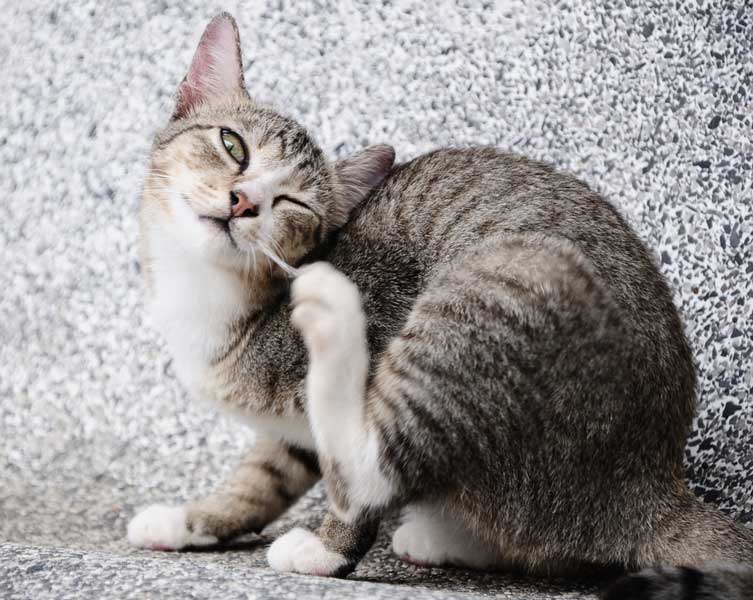Common Causes of Ear Problems in Cats

Cats that are suffering from an ear problem often do one of three things:
- Scratch of the ear with a back foot
- Rub the ear on carpet or other items
- Shake their head
If you see your cat doing any of those things, a visit to the veterinarian to determine the problem is required. In the meantime, here are the most common ear conditions that occur in cats. They're each treated differently, so it's crucial that a veterinarian properly diagnoses what's going on.
Ear Mites
Ear mites are a type of external parasite that take up residence in and around the cat's ears. They are incredibly irritating to the cat, who often shakes her head, scratches with her back feet, and holds her ears in an abnormally forward position.
Ear mites easily move from one cat to another, and kittens are most likely to be affected by them. Not only can they cause problems with the skin inside the ears, but they can also invade the skin on the head and neck, and they are often transferred to the back feet when a cat scratches her ears.
Within the ears, ear mites produce a classic type of debris which looks like coffee grounds. It's often dry and may fall out of the ears in clumps. The skin in and around the ears, and wherever else on the body ear mites take up residence, may become red, swollen, and hairless. Secondary infections very commonly set in within the ears and other skin tissue because of wounds from incessant scratching.
Ear mites in cats can be treated with several medications, including some that go into the ears and some that are applied topically to the back of the neck. Avoid using over-the-counter ear mite treatments and cleaners, which may contain ingredients toxic to cats and which won't treat other conditions that might be present.
Often, when ear mites are diagnosed by looking at the ear debris under a microscope and visualizing live mites, the veterinarian will clean out the ears well before treatment, and that might need to be repeated at home in a week or so. Secondary infections might also need to be treated simultaneously.
You can learn more here: "Ear Mites in Cats."
Otitis Externa
Infection of the outer ear canal, or otitis externa, is more common in older cats than ear mite infestation is. Caused by bacteria or fungi, these infections also cause itchiness, pain, and discomfort to the cat and produce the same signs of scratching, rubbing, and shaking of the head.
Outer ear infections can be caused by moisture getting into the ear canal, which is a more common cause of otitis externa in dogs than cats, but it does occur rarely in our feline friends too. They can also be secondary to other problems, most commonly allergies to food or inhalants.
Within the ear itself, otitis externa usually causes swelling of the lining of the ear canal, redness, and the build-up of moist, dark debris which is often stinky. Your veterinarian can use an otoscope to look into the ear canal and see things better, including whether or not the eardrum has ruptured due to the infection.
Your vet will also take a sample of the debris in the ear to examine it under the microscope, determine what type of organisms are there, and which kind of treatment is necessary to resolve it. Treatment usually involves topical medication and ear cleaning.
Otitis Media or Otitis Interna
These infections of the middle or internal ear structures of a cat can be painful and also interfere with balance. So, in addition to shaking the head and rubbing and scratching at the ear, a cat might develop a head tilt to one side, difficult and wobbliness when walking, drooping of one side of the face, and abnormal eye movements.
Infections of the middle or inner structures of the ear might be caused by an external ear infection that has broken through the eardrum and moved inward, or they might be the result of an internal infection that invaded the ear through the bloodstream.
A veterinarian might need specialized tests like a CT scan or MRI to diagnose middle and inner ear infections, and treatment can include topical, oral, and injectable medications. Surgery might also be required to resolve the problem.
Allergies
Cats with allergies often have itchy ears. Food allergies are especially known for causing itchy ears and even ear infections in cats.
If topical ear medications are required for your cat, you can use this article to help you learn how to do it: "Medicating a Cat's Ears."
Allergies can take time to diagnose, especially when itchy ears or ear infections are the primary sign shown by the cat. It might take several episodes to rule out other causes of ear discomfort and begin to suspect an allergy. At that point, the veterinarian might recommend a food trial, which is the feeding of a special hypoallergenic of novel protein diet (where the protein source is something the cat hasn't eaten before like duck or kangaroo) for a few months. If the signs of ear problems decrease while the cat is on the special diet, food allergy can be confirmed.
Injuries
The most common ear injuries that happen in cats are the result of cat fights. Outdoor cats, especially, are prone to bite and scratch wounds on their ears. The skin is good at healing up over these injuries, especially bite wounds, and that seals in bacteria that was present on the attacker's teeth. The result of this is an abscess, which is painful and can cause a cat to have a fever, feel lethargic, and stop eating.
Abscesses can be hard to see initially because they are closed, soft swellings. However, as they worsen, the hair overtop of them often falls out, and eventually, they might rupture and leak foul-smelling fluid.
If your veterinarian recommends that you clean your cat's ears as part of a treatment protocol, you can use this article to help you do it: "How to Clean Cat Ears."
Foreign Material
Cats can sometimes get foreign objects stuck in their ears, resulting in annoyance and pain. The most common foreign body that gets into a cat's ears are foxtails or grass awns. This type of grass has barbed tips on the ends of it, and when a cat goes outside and rubs on them, they can get stuck in the skin, including that of the ears, where they continue to burrow in, causing discomfort and potential infection.
Hematoma is a common secondary condition which can occur when cats scratch their ears or shake their heads roughly. Learn more here: "Ear Hematomas in Cats."
Other Causes of Ear Problems in Cats
The six causes of ear issues in cats discussed here are not the only possibilities if your cat is showing signs of ear discomfort. Polyps or tumors within the ear canal, mites on the skin around the ears, ringworm, and autoimmune skin conditions are also known causes of feline ear problems. That's why it's essential to visit the veterinarian for a proper diagnosis if your cat shows signs of an ear problem.
How Did My Indoor Cat Get Fleas?





